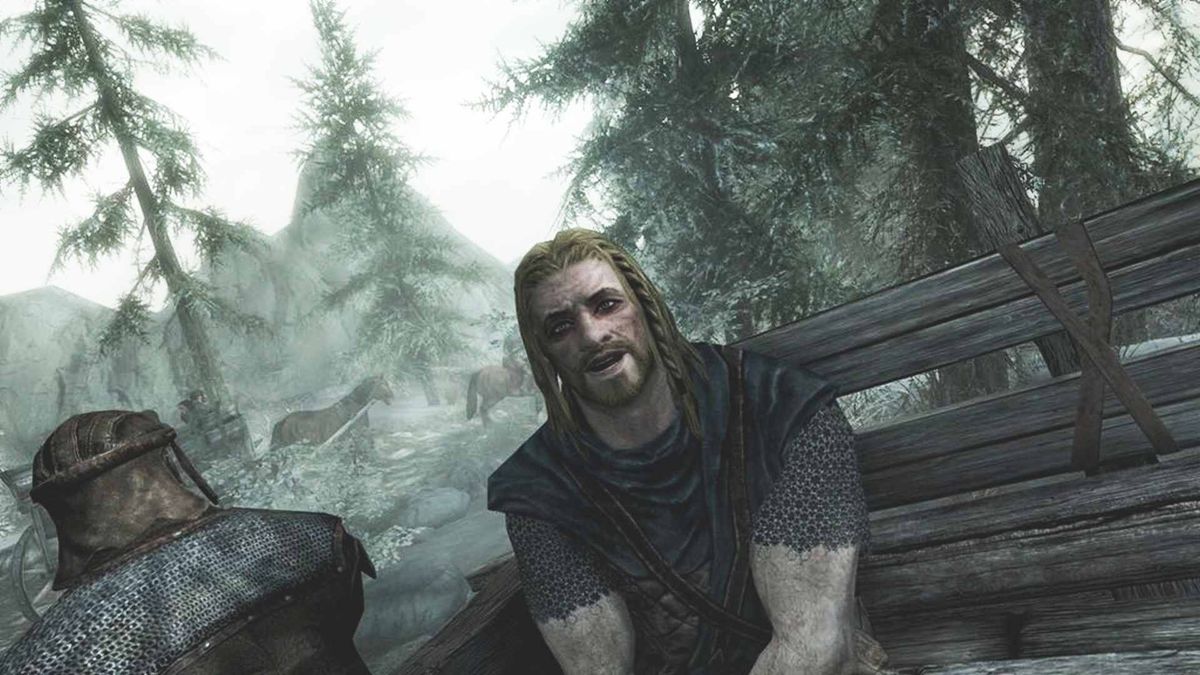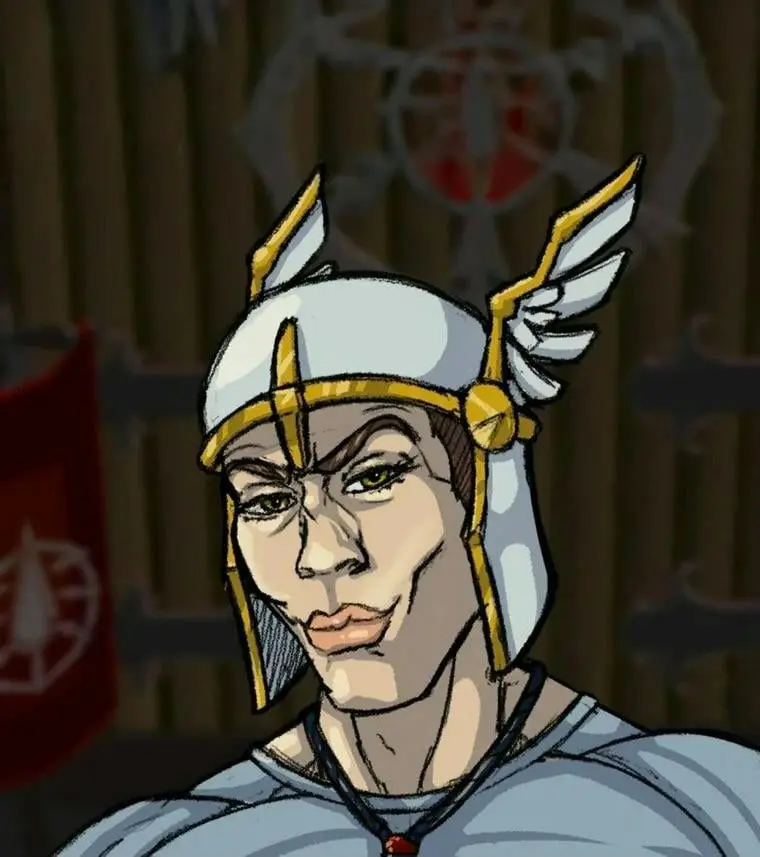World size, density, and traversal have to be balanced.
I tend to play without fast travel, and skyrim meets these three pretty well, using the carts and horse for faster travel.
GTA can be bigger, with cars and planes for long distances.
Large worlds are great, if they are packed w content, open barren landscapes are terrible.
Ghost recon wildlands for me is the sweet spot for a big, interesting world with good traversal options.
I’ve been playing Kingdom Come: Deliverance for the last few weeks and have found the balance to be pretty spot on. At first the world seems massive, and you have to travel around on foot, then eventually you get a horse and can also auto travel between locations. I think they really nailed the balance in that game.
Yeah, that game gets it right. I played it with the map turned off and the sleep walking perk and had the best time of it.
Think the second one will finally make me buy a ps5
Rdr2 is too fucking big lmao
I found it to be so immersive, that the large map size was a bonus to me. I wanted to see it all, and by god I did. I have done every single thing on that game.
I found it even more immersive by camping when it got dark out, cooking to eat, and then going to bed. When I woke in the daylight, I would sit there and have Arthur drink a cup of joe, break down the camp, and continue on with my journey to wherever.
Now I want to play it all over again for a fifth time. >:(
I’ve not enjoyed single player, Arthur is only allowed to be a cunt for story reasons, the moment I’m doing it I get penalised. It’s not bad but it’s… Eh. At least it was only $30 on sale.
Ah, I’m sorry you didn’t get to enjoy it! It is my favorite game of all time, so that’s sad to hear.
Still got my money’s worth, about 10hrs in single player, although a lot of fucking about that certainly wasn’t productive, mostly just been around valentine and the place to the east. A bit more than that online.
I’d be really interested to see an action RPG type game that just embraces the real-life scale of the world and lets you screw about with the rate of time passing like in Kerbal Space Program when you’re walking a long way. You’d have to limit the scale of the story to make it manageable to develop, but I think there’s the potential for something cool in there. Maybe there are only two or three villages in one valley, but they’re all full villages and they’re actually several kilometres apart. Make sure that whatever goals you have are time-gated in some way so that you actually have to weigh up whether you can afford to walk to the other village, because even though you fast-forward it so that it only takes a minute of real-life time to walk there it’s actually most of the day in-game.
Daggerfall was like this, if I’m not mistaken (I got into TES with Morrowind, and I’ve never found the time to play the older games).
The map was about the size of Great Britain, and mostly empty, even if it had about fifteen thousand locations spread about it.
Not quite KSP whole planet scale, but uh, Kenshi.
Its a pretty damn big world, pretty sure it is significantly larger than Skyrim.
You’ve got world speed controls, rpg style mechanics and progression, and you can have multiple members of your party, and you can build your entire own town if you want to.
The game is filled with many roving factions, who all have a sort of reputation dynamic with all other factions, as well as yourself/party.
The game is full of many different story lines, many of them conflict with each other and cannot all be done, there is no such thing as a plot armored, impossible to kill npc, and there are tons of unique, npcs you can meet and have many kinds of interactions with.
If you want to take on a huge faction, you can, but you’re probably going to need to literally raise your own army to do so.
Main downside is the control scheme is fairly awkward / old school… its basically like an mmo from the early 00’s, but single player; click to tell your peeps where to go sort of thing, awkward camera controls by modern standards for an ARPG.
You don’t directly control the combat of your character like in Skyrim, the game basically rng rolls based on you and your opponents stats to determine who uses what kind of attack or block or dodge… but you can set different combat stances, basicsally.
… So its not an ARPG in the sense of Skyrim or AssCreed or Dark Souls… but it is an ARPG in a more loose sense, that its an RPG mechanics style game and world, without rigid turn based combat, which all revolves around action.
But the scale you are looking for is there. If you don’t set the time to fast forward, it can easily take 15 minutes to an hour or more to walk between settlements or major landmarks, depending on what part of the map you’re in.
Nothing is really obvious from the onset of the game in terms if what you are supposed to do, beyond not get murdered, eat, drink and sleep to stay alive.
It’s very much a sandbox approach, but theres tons and tons of stuff to do if you are capable of directing yourself.
Also, lots of mods that add more content, immersion, and deepen or alter gameplay mechanics.
Kenshi 2 is in the works with upgraded engine and graphics… ETA totally unknown.
That sounds fascinating! I’m pretty tolerant of jank in games if they’re doing something engaging, and while I do enjoy the combat systems of the Souls games I am totally okay with a more abstracted system. Hell I love Paradox’s grand strategy games, and this sounds a lot like how battles work in those — the meaningful decision is in which fights you pick and how you prepare for them rather than your actions within the fight itself.
I tried to play that game and totally failed to grasp the controls. The idea of is is appealing. I might have to give it another go.
I am honestly kind of baffled that no one has made a mod that makes the camera/control scheme into something more up to modern standards, like a mode shift button that toggles you into a modern 3rd person control scheme.
I’d attempt it myself if my wrist wasn’t so fucked up
Outward is your game.
Never heard of this one, but I will check it out. Thank you for the recommendation!
It’s not real life scale but I have yet to see another developer attempt anything like the slice of time that we got with Majora’s Mask
Agreed. And while there are some days where my “I just want to walk as far as I can” instinct has me wishing for bigger game worlds, at the same time it can be a bad experience when the game tells you that you have to go somewhere and it’s either a slog to get there or you fast travel and skip the world entirely.
ever played Death Stranding?
I did, and I really liked it. I am excited to see how the sequel holds up, the trailer was so whacky I couldn’t look away.
I put in about 6-8 hours and never came back. Not that it was bad or anything, but I just don’t have that kind of time and it wasn’t particularly compelling. I might try it again some day, but I didn’t really understand the hype. You deliver boxes for likes and try to not fall over while walking forever in a kinda scary sci-fi post apocalypse world. What am I missing? I heard great things about it making the journey less of a slog, but if anything, it made traveling feel like more of a slog. I just had to not fall over. It’s not like I was finding that much cool stuff along the way, just occasionally a slightly useful bridge made by some other player.
It’s definitely not for everyone, but the begining does an absolutely shit job of selling the game’s depth and the more interesting bits about the setting.
As you progress through the game you have vastly different landscape types where “hold forward and don’t tip over” isn’t enough to make it through. River deltas, canyons, mountains with and without snow, swamps, craggy wasteland strewn with boulders, open plains with enemy camps, forests, etc. You also get a decent variety of tools to use to tackle those challenges, and multiple ways to approach each one.
Do I skirt around the edges of the terrorist camp or try to speed through on a motorcycle? Should I try to defeat them to make the area easier for a while? What tools do I need to get through the terrain on the outskirts? How many ladders and climbing ropes? How am I going to carry that all with the cargo and deliver it within the time limit? What do I need to defeat them? Can I? Should I do that while I carry the cargo, risking it? Should I clear it before I take on the delivery? Should I take the time to build a zipline network and then come back later when I can just zipline through? Is there enough bandwidth for buildings that I can afford a zipline network? Should I grind out some other delivery destinations to unlock more bandwidth? Maybe I should repair the highways in the area instead and drive through? How do I get the resources I need for building this stuff? Will I do repeatable deliveries for the materials, scavenge them from lost cargo in dangerous places, fight the terrorists and take theirs? Do I take on extra difficult delivery conditions (time, cargo damage) for higher rewards? How do I deal with those additional requirements?
But again, the game does a piss poor job of demonstration any of this depth off from the begining. It also does a terrible job signposting how and when you unlock more tools. So you can grind shit out the hard way, then do one mission for someone different (that you could have done the whole time) and unlock something that would have made the grind half as difficult. Shit didn’t really “click” for me until more than 20 hours in, which is pretty unforgivable.
For anyone thinking about playing or picking it up again, my advice:
Get the deluxe edition. It has a bunch of seemingly minor QoL additions in terms of new equipment and some added functionality for old ones that make a ton of difference.
Slam through the starting area. Unless you really want to grind, just do the main quest path and ignore the side stuff. You can come back later with gear that will keep it from being such a slog. This would have cut down my “20 hours until it clicked” by a ton.
After you take the boat to the second map, you can take things slower. I reccomend focusing on the main quests until you unlock each new “hub”, then do as much side content as you’re interested in. On the second map the game does a better job of indicating the story sections in advance that you might want to grind out side content to be better prepared for.
Most of all, don’t treat Death Stranding like a normal game that’s meant to entertain and keep you hanging on for the next beat. It’s a slow, contemplative game while you grind out sidequests. I mostly play it to relax. Put a video up on my second monitor, or listen to a podcast, and deliver shit.
I’d also like to throw another good point to the ones you have provided: The game is also about helping other players along on their journey.
Once I got to the good equipment, I laid down as much as I could to help others on their journey. I even went as far as grinding (which I legitimately hate doing) to build the roads, build the zip lines, and fixing other people’s equipment that I had used.
That, to me, was one of the cooler aspects of the game!
I had the exact same experience and don’t know what I’m missing that everyone else loved so much. It was all just so tedious.
I really wanted to like it, but nothing about the game hooked me. The world was cool and graphics were good but the core gameplay loop was tedious. I was hoping for a more interesting or threatening world to explore. The random objects placed by “xXXgamer420xXx” didn’t help my immersion. I wonder if the game would have been as successful if Kojima’s name wasn’t attached to it.
Same. I struggled with RDR2 and gave up on Elden Ring.
Damn I’m literally playing Wildlands now. It’s a really fun game to just drop in if you want to cause some mayhem.
8 times bigger than Witcher 3 filled wilth Witcher 3 quality content would be a godsend. 8 times bigger than Witcher 3 filled with procedural generation and AI slop… not so much.
I will argue that Witcher 3 did not have enough content for it’s own world. Don’t get me wrong, the content was great, but there’s large swathes of emptiness inbetween. The devs tried to fill it with map markers that got repetitive very quickly (hello, random floating barrels).
IMO, downscaling the world to 75% size and reducing the amount of non-quest content would have made the game better.
The whole reason I burned out on W3 was trying to be completionist and doing all the map markers before moving to the next area.
Honestly I think these games need more points of interest that are not marked on the map whatsoever, and don’t matter towards 100% completion.
I eventually went through the Witcher 3 post game and got every single marker but it was basically background work while I listened to audiobooks, I didn’t come across anything interesting for hours. However I do acknowledge that those markers aren’t necessary meant to be sought out, but stumbled upon.
This is honestly what also happened to me. I did not finish the DLC.
If we’re copying Witcher 3 levels of content anywhere, can we leave behind like 95% of the ocean based points of interest? That was the absolute lowest point of the game for me by a mile.
I would be happy if they never touched wayer again. Swimming and boating were awful in The Witcher series.
I do think a huge world with an engaging and dense design can still be made worse with size. In some games like Skyrim, Breath of the Wild or GTA 5, you could probably drop me anywhere and I’d know where I was, half due to good and differing region design and half because the map isn’t that big.
Back in 2015 I’d dream of a GTA 5 expansion that adds San Francisco and Las Vegas to the map, turning the north and east of the map in to a 500 yard straight of water, but in reality, two more large cities and their surroundings suburbs and wilderness would have never kept it’s memorability like the first region.
Slightly OT, but I want to give a shout out to Witcher 3 as my favorite fantasy RPG.
Early on in the game I kind of struggled with it. I found the UI and especially combat, to be ‘clunky’.
After I mastered the combat UI enough to survive, I started to wander and explore. In this wandering I found some old cave filled with some decent (but not overpowered) gear. As far as I know, there was no quest that would have sent me to this cave. Also, if I hadn’t been pointed in the exact direction I was going, I never would have seen the cave entrance. These little details made the world feel ‘real’ and lived in.
Later in the game, when I was much more experienced, I was following a faint path, in the snow, over a mountain and I see another cave entrance. I go inside the cave and I hear voices. I sneak closer and I hear a fart, Then I hear a voice complaining about the smell of a rotten onion. (it was 2 trolls cooking something). This was totally unexpected and I literally LOL’d. Once again, this little bit made the world feel more real.
In summation, I don’t need games to be ‘bigger’. They just need to be ‘good’.
I would never finish a game 8 times longer than Witcher 3+exansions. I started once, got burned out and had to restart a year later to get to the end. Enjoyed it a lot but yeah. I don’t need like 1600 hours of anything.
1600 hours is insane gameplay loop not content size imo, I have that amount of hours in a few game but they’re either fighting games or ARPGs which are repetitive by nature.
*cries in osrs*
OSRS has obliterated my sense of what constitutes a grind. I’ve communities for other games tearing their hair out over a 1/300 drop.
Same. Someone’s like, oh a 3% drop that’s awful!
And I’m like, oh 3%? That’s like, a tiny coin drop or random trash right?
that’s hilarious, you should introduce them to the old DWH rate, and include that it was a mandatory grind for every iron lmao
I feel like how big I want the game to be is a weird quantum unstable value. When I’m interested in the game I want it to keep going. But at some point I lose interest, and I want it to wrap up. But usually I don’t want to skip content that’s at least okay, especially if it affects endings and other choices.
Like I enjoyed Veilguard, but there were bits near the end where I was losing focus and kind of wanted it to pick up the pace. There have been other games where I finished all the side quests but was like “that’s it? I want more”
Not sure how to square this circle. I don’t think procedural generated or AI content is quite up to the task yet.
I do think we’ll see a game that has AI content in the critical path in the next couple years though. You’ll go to camp and talk to Shadowheart, and it’ll try to just make up new dialogue. I don’t know if it’ll be good. There will probably be at some weird ass hallucinations that’ll become memes.
Same happened to me with Zelda: ToTK. I did everything I came across, collected a lot of things I found, did a lot of questing, got so good in combat I could defeat everything without getting hit, but then I was like “it’s time to stop now” and I defeated the final boss and put the game down. It was amazing.
I do think Botw and Totk would have benefited from having the map 50% smaller to condense the content. The underworld in Totk basically ended up just being collecting DLC armor from the previous game.
Which is weird, because I totally spent like 40 hours in there lol
Oh, I spent a lot of time in there, thinking I’d find more than another mini abandoned mine site or yiga lair. The most interesting thing was the yoga boss fight. The underworld portion could have probably been turned into a really great post game idea if they had spent more time on it.
I feel like how big I want the game to be is a weird quantum unstable value. When I’m interested in the game I want it to keep going. But at some point I lose interest, and I want it to wrap up. But usually I don’t want to skip content that’s at least okay, especially if it affects endings and other choices.
I’m kind of at this spot right now with Pathfinder: Kingmaker. If I had realised it was a 200h+ game I might not have undertaken it. I’ve had a good time with it all things considered, but at this point I really kind of want to move on to the next game in my backlog.
If it’s good it’s good. I bought the witcher 3 DLC and would have bought more. I stopped playing Assassins Creed altogether. People just want good, crafted content.
What game developers should do is add more “jump back in” modes. I get busy with work so I might leave for a few months midway through a long game and forget some plot and controls.
I would super appreciate “Jump Back In” mode…
I’d love the option in a tutorial that for “I’ve played plenty of this kind of game - tell me what’s specifically different in this game”.
Oh hell yes! We need this!!
Honestly one of the best games I’ve played recently is the Stanley Parable and that game is a couple of hours of poking around a quirky but literal office. Would happily buy that 60 times over one massively mediocre rpg.
He’s right. We don’t need maps bigger than Skyrim, we just need content and good core gameplay loops. Being hugely moddable like Skyrim really helps too.
Mods definitely help. Same reason why I think Fallout 4 is such a big hit.
Exactly. GTA V’s biggest selling point was the worst part for me: giant map. The only way a giant map is good is if it has a ton more fun stuff to do, and even then, I’d honestly rather have a sequel/series instead of throwing everything in one game.
I still prefer gta 4, the city was worn out, lived in, cramped and dense.
Same. I mentioned SA mostly because both are in Los Santos.
I want worlds big enough that I can suspend disbelief. True scale is too much (True Crime: Streets of LA was awful to traverse, for example) but too small and it feels like being in one of those play parks for small children. It’s a problem I’ve had with Fallout 3+, where the scale makes no sense. I don’t necessarily need the additional space to be dense with content (if it’s supposed to be a barren waste, why is it full of stuff?!).
I want to buy into these worlds, but I struggle when things feel ridiculous. Oh are you struggling for supplies? Even though there’s supplies 50m away from your settlement? Come on!
The first Red Dead Redemption hit the spot for me, as did the native settlement in Shadow of the Tomb Raider. The scale isn’t actually realistic, but it’s large enough that I feel like it could be. GTA IV wasn’t bad either, but GTA V was too compact in many places for my tastes.
I suppose it’s much like the theatre. If a scene is well written it feels fine, but if the play calls attention to the limitations of the medium too much then it starts to become a bit silly.
Good point. If you look at the Yakuza games, they’re typically set in a little entertainment district. The map isn’t huge but it’s not supposed to be. It feels the correct size for a busy little part of town.
Meanwhile, yeah, Fallout 3 gave me the impression that even before the war the DC metropolitan area was home to maybe a thousand people.
I recently rewatched Rango and the size of the main settlement in that is about the size of those in RDR. Reflecting on that, I suppose I want the map to reflect the kind of scale and focus seen in other media. A film or TV show doesn’t show us every street (usually) but it gives a sense of the scale of the place. If a game map couldn’t be used for an establishing shot without looking daft then it doesn’t really work for me, I reckon.
It’s something I like about the overhead perspective used by games like Fallout and Wasteland - I perceive what’s on screen as the area of the settlement that’s relevant to me but with the understanding that there’s more off screen. A character might mention going somewhere, much like in a play, and then reappear. Perhaps the player can go there, perhaps they can’t even see it, but it makes the world feel larger.
I suppose, much like in reality, we rarely visit every location of a place, but it needs to feel like it might enter our narrative in some way.
The advantage of putting those supplies 50m away though is that it makes a better video game. Playing The Outer Worlds right after Starfield made me a-okay with every way they shrunk the Bethesda experience.
How are we defining “better”? For me it makes the experience worse because I lose all immersion. I’m trying to be immersed and my brain can let a lot slip (realism is not required!) but for me the limit is when it strains even basic credulity. Yes, 50m makes the quest less hassle, but if I don’t care about the quest due to the scope of the world then there’s a more fundamental issue.
In games where immersion isn’t a factor (e.g. The Binding of Isaac) that stuff doesn’t matter. In an explorable open world I content that it’s rather crucial.
All the immersion Bethesda could muster couldn’t make Starfield a better game than The Outer Worlds. The criticism was frequently that they made 1000 planets but that it would have been better if they’d focused on making 5 good ones, which is basically what Outer Worlds did. Putting the metaphorical supplies 50m away is what they found led to the best pacing, so suspend your disbelief a bit, and have a better time than if they’d put them further away. This isn’t prescriptive, btw. If it’s not your preference, it’s not your preference, but I think most people would prefer the compromise to immersion when it makes the game more fun.
The criticism was frequently that they made 1000 planets but that it would have been better if they’d focused on making 5 good ones
I take zero issue with this! I think you’re misunderstanding my point.
Putting the metaphorical supplies 50m away is what they found led to the best pacing
I’m not talking about a metaphorical 50m, I’m talking in the game world 50m. It’s not an analogy for game design, I mean in a very literal sense that the worlds are a bit too small for my tastes.
I’m not talking about density of content or the number of locations in a game. I am talking about the level of size scaling that has been applied. Too small and I cannot get immersed, too large and it makes for a tedious play experience (that’s why I cited True Crime: Streets of LA, that uses 1:1 scaling for LA and as a result has a lousy overworld).
For my tastes the balance currently leans too heavily towards ludicrously small in many games. I quite liked the scale of the Watch_Dogs games, as a counter example.
Hell, it’d be cool if there was an engine that used something like content-aware scaling to adjust the distances to player preferences. Some people want a slog (that seems to be Death Stranding’s deal) and others want Wannado City.
so suspend your disbelief a bit
If this was advice I was able to act on then we wouldn’t be having this conversation. If this was an option, I’d do it! Do you think I enjoy being frustrated at this?! No! I wish it didn’t bother me! It’s a nuisance and gets in the way of fun!
I’m not talking about a metaphorical 50m, I’m talking in the game world 50m. It’s not an analogy for game design, I mean in a very literal sense that the worlds are a bit too small for my tastes.
But the size of the world is a part of the game design. What’s too big for The Outer Worlds might be just fine for Mad Max simply because one of those games lets you drive a car. The distance that those supplies can be away from where you start is dictated by what mechanics you have at your disposal to get there. It’s metaphorical because we’re talking about any time a game makes a decision like this with relation to how they scale their game world, not just that one time that you measured it out to be 50m.
I do think it’s worth examining why this is harder for you to suspend disbelief than other things in video games. You suspend disbelief every time your character loses or gains hit points rather than suffering actual injuries that need time to heal. You suspend disbelief any time you play a game in a real world city that isn’t represented in 1:1 scale (that’s basically all of them) like The Division or Spider-Man. So to the same end, I’ll take those supplies that are 50m away and it’s somehow too far for the quest giver to go get them, because it’s best for the design of the game, just like the scale of the world that they built.
It’s metaphorical because we’re talking about any time a game makes a decision like this with relation to how they scale their game world, not just that one time that you measured it out to be 50m.
That might be what you’re choosing to talk about, but it is categorically not what I was talking about.
But the size of the world is a part of the game design. What’s too big for The Outer Worlds might be just fine for Mad Max simply because one of those games lets you drive a car.
I know! I understand!
That’s why I picked a specific example of where I feel the balance in some popular games is poorly implemented for my tastes. Some games manage this well, some do not, and I feel that this often errs on the side of “50m outside the settlement”. Based on your comments, that doesn’t bother you.
Great, I wish I was as lucky.
For me, an open world game that gets the scaling wrong is not very fun to explore. Whether that’s too big or too small. It seems lots of gamers aren’t fussed about this. Arguing with me that my preferences are wrong doesn’t seem worthwhile. I understand the game design principles, that was never the issue.
I posted this because I think it’s interesting to compare notes on the parameters of this element of game design. What sort of scaling is too big? Why? How many people should be visible in a settlement to feel right? That sort of thing.
I do think it’s worth examining why this is harder for you to suspend disbelief than other things in video games. You suspend disbelief every time your character loses or gains hit points rather than suffering actual injuries that need time to heal. You suspend disbelief any time you play a game in a real world city that isn’t represented in 1:1 scale (that’s basically all of them) like The Division or Spider-Man. So to the same end, I’ll take those supplies that are 50m away and it’s somehow too far for the quest giver to go get them, because it’s best for the design of the game, just like the scale of the world that they built.
I’m not sure what your point here is? That my brain is broken? As I said, if I was able to overlook it, I would. I’m pretty sure I also said that I wasn’t looking for 1:1 as it actively hampers game design.
There’s more options than 1:1 or Wannado.
Games like Skyrim always bugged me a bit as I couldn’t walk for more than half a minute before I tripped over a quest or encounter of some sort. I feel like the devs were scared players would get bored if they didn’t see something exciting every few seconds. Sure I want to do stuff, but I also want to breath and look at the scenery and think about what I’m doing.
The real world is way more open; you travel for a good while between cities, and I really like when games do that as well. I’ll have to try Red Dead, but I thought Kingdom Come Deliverance struck a good balance. Even at top speed on a good horse, it takes minutes to ride between the major settlements, with only rare encounters coming up now and again.
I’m glad to hear it’s not just me (I mean, statistically that seems unlikely, but still!). It’s a little like modern cinema compared to '70s film making - let the story breathe, folks. Given that the tooling to make the world larger (but with the same amount of content) isn’t all that complex, I wish it was done more. The amount of content is fine - often excessive. But give me a chance to feel like I’m actually travelling.
I felt the scaling of Assassin’s Creed Origins and Odyssey worked quite well in that respect. There was actual travel!
The only thing that I hate from open world is emptiness, you can have big or massive world but if it’s seems so empty why bother to make it. Like Fallout & Skyrim we always use mods to fill that emptiness to make it feel alive.
I rather have game with small world but filled with many NPC like old Dragon AgeBig reason I don’t understand the obsession with Breath of the Wild and Tears of the Kingdom. The game world is empty and just feels like so much wasted space, and a ton of it looks like PS2 worldbuilding.
I didn’t play Tears of the Kingdom, but if you found large swaths of the map to be empty in Breath of the Wild, it means there’s something hidden there that you didn’t find.
It’s just about density. BotW/TotK were eerily empty and dead. But something like Elden Ring? I would play a game 10x the size of Elden Ring for the rest of my life.
This is my biggest complaint about No Man’s Sky. There are literally over a billion billion worlds, but they’re all mostly empty, not to mention all the space in between.
I played NMS ~2 years ago and thought for a huge procedurally generated game it was pretty good. The planets had lots of POIs and trading posts and stuff to go to. I quit mostly because the flight mechanics were too “on rails” compared to something like Elite Dangerous or X4. I just didn’t get the rush I was looking for from dogfighting and stuff. I had constructed a series of bases that let me craft a ton of tradable items that gave me plenty of money but there was just nothing to spend it on because my ship was already plenty strong enough for everything I encountered…
Don’t get me wrong, I love the game. But especially in the beginning before you start getting some upgrades, everything is sooooo far away and there’s so much emptiness.
Can I ask when you played it? I didn’t have that perception at all. There was some kind of “hub” you could jump to and plenty of stuff around wherever you were at. It was mostly about finding a planet that had whatever combo of resources you needed but that didn’t take very long either. I only played for a couple weeks but my understanding is there were quite a lot of quality of life updates between launch and when I played. Maybe you just tried it before I did. Either way you’re entitled to your opinion.
The biggness doesn’t matter as much as how much there is to do in a meaningful and rewarding way.
Horizontally I’m fine with how big games are. They should grow vertically, and I wouldn’t mind 6 times the depth.
What do I mean by that? I have no idea. Maybe you people have
A cyberpunk game that takes place entirely in a replica of the Kowloon walled city would be cool as fuck. Just as much map “area” as fallout 4 but packed into a 1 mile cube.
I’ve thought a lot about this. It would have to be a game with no combat. Too cramped. It’d be a nice puzzle game like Myst, tho.
Edit: Stray 2: Kowloon
Wait I had a similar idea once! Youre right that would be cool af, but very difficult to get right. In open world games you usually get away with “isolated” side quests, in a dense cube this is difficult – which might be a good thing, it forces interconnectivity.
I was nodding along in agreement but now that you mention it I also didn’t really know what you were saying
No, no he has a good point, let him finish
I’d interpret vertical content growth as content per area, deep story lines, stuff like that. It’s a common enough comment, see e.g. MMO players complaining about “content drought”.
Skyrim is huge. I played it last year, going to all locations and doing main and side quests. That takes 100 hours or so.
Now I’m playing Elden Ring with SOTE, doing the same thing. I’m around 180h in and honestly I kind of want to finish by now.
So yeah, I don’t see 600 hours of playtime as a positive goal. Unless they mean expand the map but don’t keep up the content ratio. In that case, why the fuck would that be good? More travelling isn’t worth anything.
Honestly, my limit is about 80 hours, and that’s only if the store and side content is really good. An average story/RPG game should target 20-40 hours IMO.
Skyrim size was just about right. I just want a deeper stat sytem that promotes more build diversity than stealth archer (but keeping the skill tree system intact - never want to go back to the Morrowind/Oblivion systems), enemies and items that don’t level with me, more monster variety (so sick of draugr), and bring back levitation and modifiable acrobatics!
Morrowind still has the best skill system concept. “Do what you think is fun and you will level up and get better at it” is great game design.
Things that are the kernel of bad game design: Fetch quests in quantity, especially over large maps with limited fast travel points (fuck you Witcher, cyberpunk), having eleventy billion containers which just might be good to open (fuck you baldur3/divine divinity/Morrowind), or having an inventory system that makes you crave death every time you use it (same), or having an inventory system that makes you do endless, constant field checks to figure out which weapon or armor is best because you don’t have space for more than 3 things (sooo many games, but cyberpunk, deus ex, and borderlands get a big old fuck you from me).
I agree with pretty much all of your points, especially about limited inventories. In isometric arpgs in particular it drives me crazy that half the gameplay is essentially a gambling system of explosions of massive amounts of items - yet they give you virtually no room to carry it? Terrible.
But on Morrowind, I love the game with mods like MULE, but the vanilla level up system makes the stat system self-defeating. The purpose of skill-based progression is to let me play the character I want to play, and do the things I want to do, and trust that my character is going to grow accordingly. But the level up stat multiplier system forces the player to do all sorts of things other than what they want, in order to get the most out of the stat system.
It’s even worse in Oblivion because everything levels with you much more in that game, which means if you don’t do these ridiculous things to min/max, your enemies can actually become too powerful to beat!
Oh I won’t disagree that they tuned it weird…same thing for the enemies. Being defeated by an overleveled mud crab is…demeaning. and more generally I still recall putting my character in a corner, hitting q, and leaving for the day so she’d be a good runner when I got back…which is just downright dumb. But the concept at it’s core is beautiful, and I wish more games would investigate that concept until we find a really good solution.
I forgot, there’s one other super shit rpg thing that always pisses me off even though it’s literally everywhere: why do I have to pick skills before I even start playing and understand the rules? SPECIAL, stat points, attributes…whatever a game wants to call it, I want to play first before I do all the math on what is the best skill to use.
Todd Howard better be on Lemmy. Would be the best thing to happen to fallout
if they get rid of the special picking at the start of the game the new vegas fanboy crowd will literally crucify todd howard
I think the issue is that most game’s core gameplay loops are not endlessly replayable. Lots of single player RPGs fall into the trap of being alright to progress through for maybe 20 hours, but you can quickly become so powerful that the rest of the game falls into busywork. It’s really hard to meaningfully introduce new and interesting gameplay after the 30 hour mark, but without it things become same-y.
I’d argue this is just a fault of poor game design though. There are RPGs with really well iterated gameplay loops, with a wide array of variety, that I’m happy to put 400+ hours in. Games like Baldur’s Gate 3, or Elden Ring, have a lot of freedom and variety in the way you can approach a playthrough, even allowing you to dramatically change things mid-playthrough, while still feeling mechanically satisfying to play. A 10/10 game will feel good to play forever, but a 7/10 might get boring after 15.
I look at the RPGs I enjoyed and the ones I didn’t and I think what I want more than anything in RPGs is for them to be fleshed out and well fitting.
If the world is too big for the story it feels empty and the side quests don’t feel connected. If it’s too small, it feel cluttered. It’s a fine balance.
A lot of quests in games have a specified start and an end, and are unimaginative. It’s 2025. I’m not bringing somebody 20 orc horns for a slightly better sword. Well, I will, but I don’t want to. It just feels lazy.
I’d rather stumble across a thread woven into the world and follow it both ways to it’s logical conclusion, choosing any branches along the way.
Honestly, I think “big” works against developers if they’re trying to make something that just fits. When you look at something like BG3, the world isn’t that huge. But once you start filling out all the blanks, it takes you a long time to get through.






















